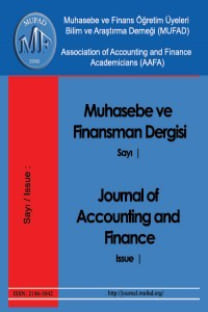Internet Denetim Teknolojilerinin Balkan Ülkeleri’nde Kullanılması
Bu bildirinin amacı, tüm dünyada kullanılan internet denetim teknolojilerinin metodolojik ve teknik açıdan ele alınması ve de Balkan ülkelerindeki kullanımı hakkında bilgi vermektir.Geleneksel finansal raporlama ve denetim yolları göstermişlerdir ki bunlar her zaman için yeterli değildir. Bunun sebebi, günümüzün iş dünyasına ait temel unsurların yani güncellenmiş bilgilerin olmayışıdır. Son zamanlarda kurumlar, standartlandırılmış finansal bilgiyi olması gereken zamanda, on-line olarak üretmeye yönelmiştir.Bu bağlamda internet denetim teknolojisi süreci teknolojik yenileştirmeyi kesintisiz devam ettirmelidir. Söz konusu yenileştirmeler, şu başlıkları içermektedir: değerleme kontrolü, otomatik çalışma kağıtları, bütünleştirilmiş ve kesintisiz denetim. Bunun dışında, denetim ekipleri, uzmanlaşılan uygulamaların yardımıyla belirli bir biçim çerçevesinde, kendi denetim çalışma kağıtlarını oluşturmaktadırlar (risk analizi, denetim planı, denetim programları, sonuçlar, test kanıtları, raporlar ve diğer tamamlayıcı bilgiler gibi).Bütünleştirilmiş denetim, denetimin uygun biçimlerinin varlık, süreç ve işlemler aracılığıyla iç denetim araçlarının bir araya getirilmesi süreci olarak tanımlanabilir.Kesintisiz denetim çok sayıda işi içermektedir. Çünkü devam eden denetim uygulaması yapan firma, daha sık finansal rapor hazırlayacak ve bu sadece bir dönem sonu raporu olmayacaktır. Devam eden denetim süregelen kontrol ve gözlemleme faaliyetlerinden bağımsız olmalıdır. Denetim ve gözlemleme faaliyetleri eş anlı olarak gerçekleştirildiğinde kesintisiz güven kurulabilir. Daha basit kesintisiz denetim ve gözlemleme araçları birçok işlem aracı ve network güvenlik paketi içerisine dahil edilmiştir.Balkanlarda internet denetim teknolojileri bir disiplin olarak son yıllarda ortaya çıkmış ve git gide gelişme göstermiştir.
Anahtar Kelimeler:
İnternet denetim teknolojileri, otomatik çalışma kağıtları, birleştirilmiş denetim, kesintisiz denetim, Bilgi Sistemleri ve Kontrol Birlikleri, Yeminli Bilgi Sistemleri Denetçisi-CISA, Yeminli Bilgi Güvenliği Yöneticisi-CISM, COBIT, CSA.
IT Audit Trends Within Framework of Balkan Countries
(IT Audit Trends Within Framework of Balkan Countries) This paper tries to present an analysis of the IT audit worldwide trend from methodological and technological point of view as well as the IT audit activities within the Balkan countries.Traditional financial reports and conventional ways of performing an audit proved to be not always enough because the lack of the essential element in today’s business environment -updated information. Nowadays, organizations are required to produce standardized financial information on a real-time, online basis.The IS audit process must continually change to keep pace with innovations in technology. New topics to address these emerging changes include control self-assessment, automated work papers, integrated auditing and continuous auditing. Moreover, audit teams are creating their audit work papers (risk analysis, audit plan, audit programs, results, test evidences, conclusions, reports and other complementary information such as business information) with the help of specialized applications, designed for delivering an automated format.Integrated auditing can be defined as the process where appropriate types of audit are combined for assessing key internal controls over an operations, process or entity. The integrated audit demands a focus on business risk and a drive for creative control solutions.Continuous auditing involves a large amount of work because the company practicing continuous auditing will provide financial reports on a more frequent basis, and not just one report at the end of a quarter. Continuous auditing should be independent of continuous control or monitoring activities. When both continuous monitoring and auditing take place, continuous assurance can be established. Simpler continuous auditing and monitoring tools are already built into many ERP, CRM, SCM packages and most operating system and network security packages.In the Balkans, the IT Audit emerged as a discipline in the past years and is growing quite fast.
Keywords:
IT audit, automated work papers, integrated auditing, continuous auditing, ISACA, CISA, CISM, COBIT, CSA.,
- ISSN: 2146-3042
- Yayın Aralığı: Yılda 4 Sayı
- Başlangıç: 2005
- Yayıncı: Muhasebe ve Finansman Öğretim Üyeleri Derneği (MUFAD)
Sayıdaki Diğer Makaleler
Ekonomik Büyümenin Anlamlılığı ve Gelişmişlik: Türkiye Ekonomisi Üzerine Bir İnceleme
2007 Merkezi Yönetim Bütçesi Üzerine Düşünceler
Euro’ya Geçiş ve Türkiye’nin İthalatına Etkisi
Yabancı Sermaye Yatırımlarının Ekonomik Büyümeye Olan Etkisinin Türkiye Bağlamında Test Edilmesi
Muhasebe Meslek Mensuplarında İş Tatmini İle İşten Ayrılma Eğilimi Arasındaki İlişkinin İncelenmesi
1. Balkan Ülkeleri Uluslararası Muhasebe ve Denetim Konferansının Değerlendirilmesi
Sürdürülebilir Kalkınma ve Çevre Muhasebesi (II)
Dış Kaynak Kullanımı (Outsourcing): Antalya Yöresindeki 5 Yıldızlı Otellerde Bir Araştırma
